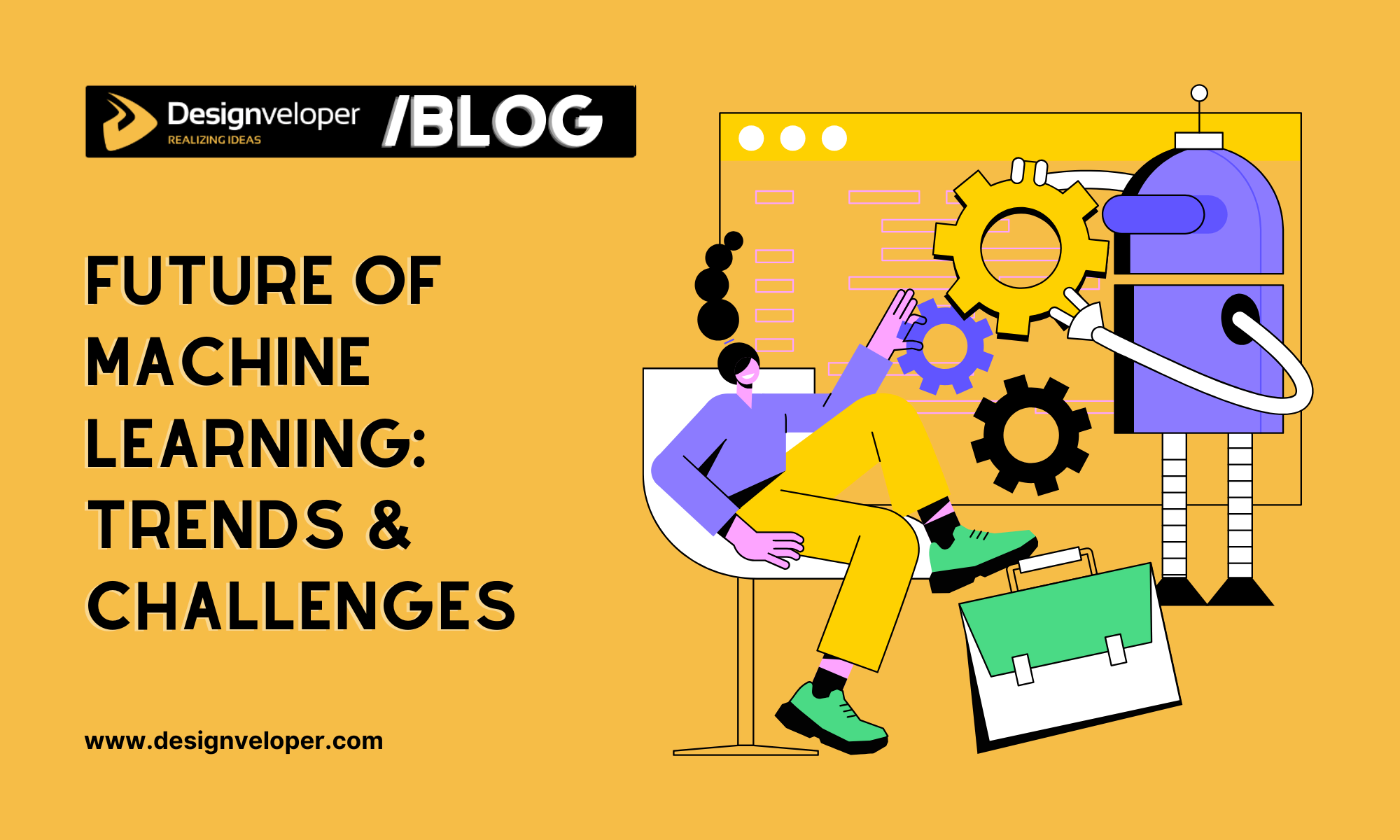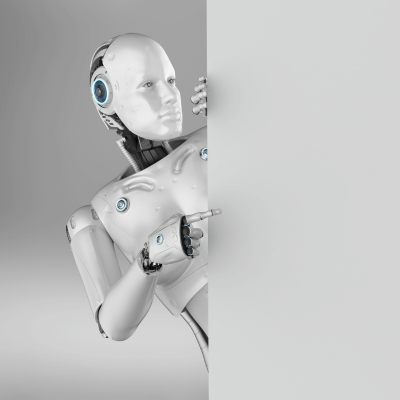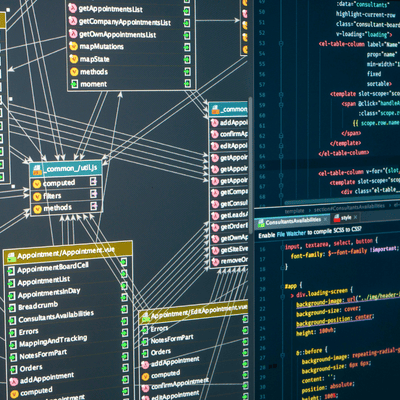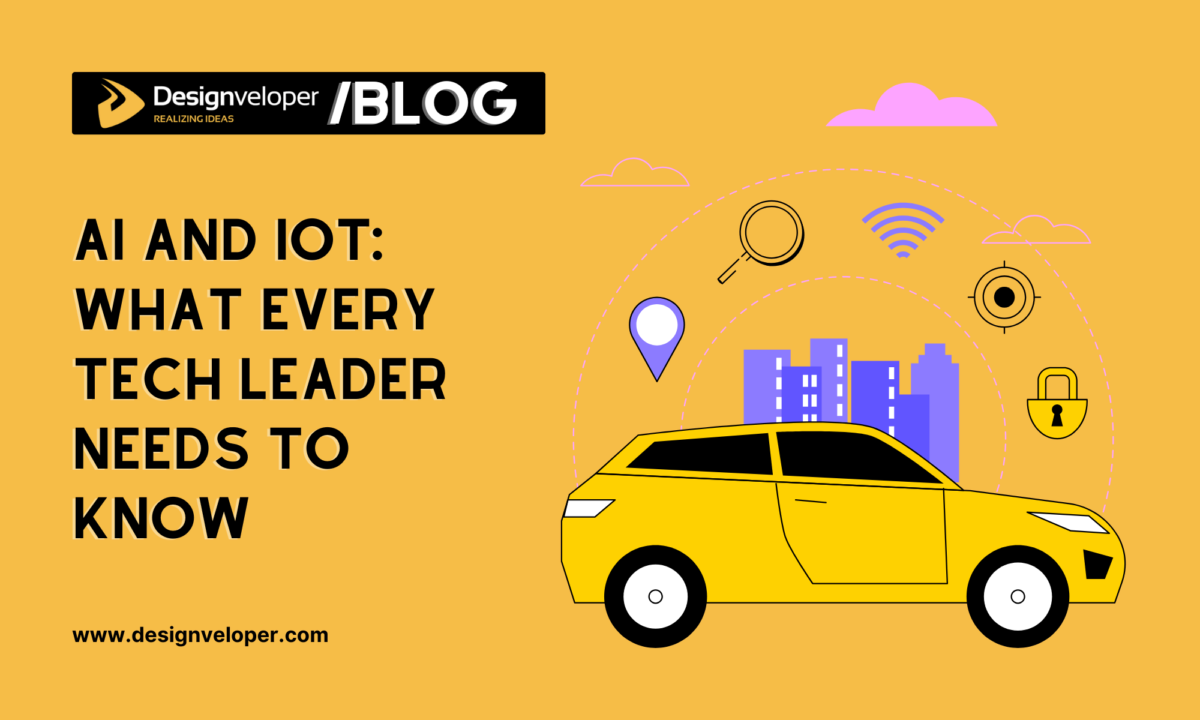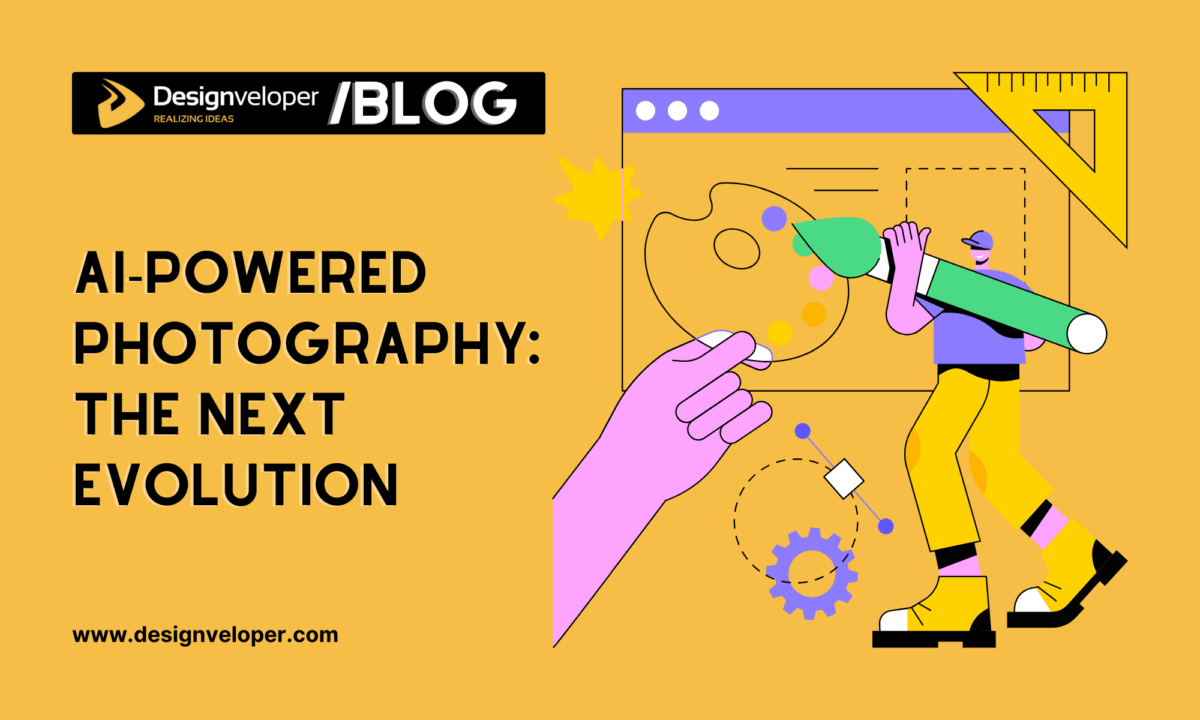
Machine learning is transforming something we once thought impossible, from self-driving cars to personalized recommendation systems. As a powerful part of Artificial Intelligence (AI), ML refers to developing an algorithm that can analyze data without being explicitly instructed. With these ML algorithms, machines like cars or robots can automatically conduct data analytics and make certain decisions as our brains do. This capability gives us a positive vision for the future of machine learning.
So, what is exactly machine learning heading next? In this article, Designveloper will explain emerging and potential trends in this realm, along with challenges and preparation you should consider to stay ahead of these trends. Ready? Keep reading!
History and Growth of Machine Learning

Machine learning has a rich history. From the idea of how to make machines think as we did in the early days of AI, machine learning is now a powerful technology that appears in every corner of our world. To understand its history and evolution, let’s travel back to the 1950s where its story began.
Early Foundations (1950s)
In fact, the theoretical framework for how machine learning works appeared previously in studies about human cognitive systems.
In particular, Canadian psychologist Donald Hebb and other researchers introduced a theoretical neural structure of nerve cells that communicate with each other. Like our brains, machines also use artificial neurons that require ML algorithms to analyze and exchange data.
Arthur Samuel, an IBM researcher in AI and computer gaming, coined the term “machine learning” when he invented a corresponding program that could compute the winning chance for check players in 1952. This program can be considered a form of later reinforcement learning. Also in 1958, Perceptron – the first machine developed by Prof. Frank Rosenblatt – was an early type of neural network that could produce original ideas and classify data.
Rise of Algorithms and AI Winter (1960s – 1990s)
During this period, research in machine learning continued with outstanding achievements. Noticeably, in the early 1960s, Raytheon Company invented Cybertron, an experimental self-learning machine using rudimentary reinforcement learning to analyze sonar signals, speech patterns, and electrocardiograms. Further, fundamental ML algorithms were introduced, like Nearest Neighbor (for pattern recognition) or Decision Trees (for predictions based on input data).
However, in the 1970s-1980s, we witnessed an AI Winter, when funding and interest in AI/ML were reduced. Accordingly, the Lighthill report accused AI of lacking practical success, leading to the complete abandonment of AI research in the UK. The same also occurred in the US after DARPA’s report about unfruitful AI studies.
However, the late 1980s then saw renewed interest in machine learning and neural networks due to new achievements. For example, the Backpropagation algorithm developed in 1986 enabled neural networks to learn more effectively. Meanwhile, Support Vector Machines (SVMs), which were invented in the 1990s, supported task classification. These algorithms paved the way for advanced ML capabilities, typically deep learning.
Flourish (1990s – Present)
Until the 1990s, machine learning thrived and was recognized as a separate field. There were several factors propelling this growth. They include increased computer power, the availability of big data, and algorithm advancements.
Further, ML shifted its initial goal from achieving the overall goal of AI to handling practical problems (e.g., detecting fraud or forecasting customer behavior). Embracing this new objective, modern-day machine learning focuses on classifying data and predicting future outcomes based on already-built models.
Also in this period, we’ve seen the emergence of ML subsegments like deep learning, natural language processing, computer vision, and more.
FURTHER READING: |
1. AI-Powered Photography: The Next Evolution |
2. AI and IoT: What Every Tech Leader Needs to Know in 2025 |
3. What is Voice Technology? Definition and Examples |
Overview of Machine Learning in Today’s Landscape
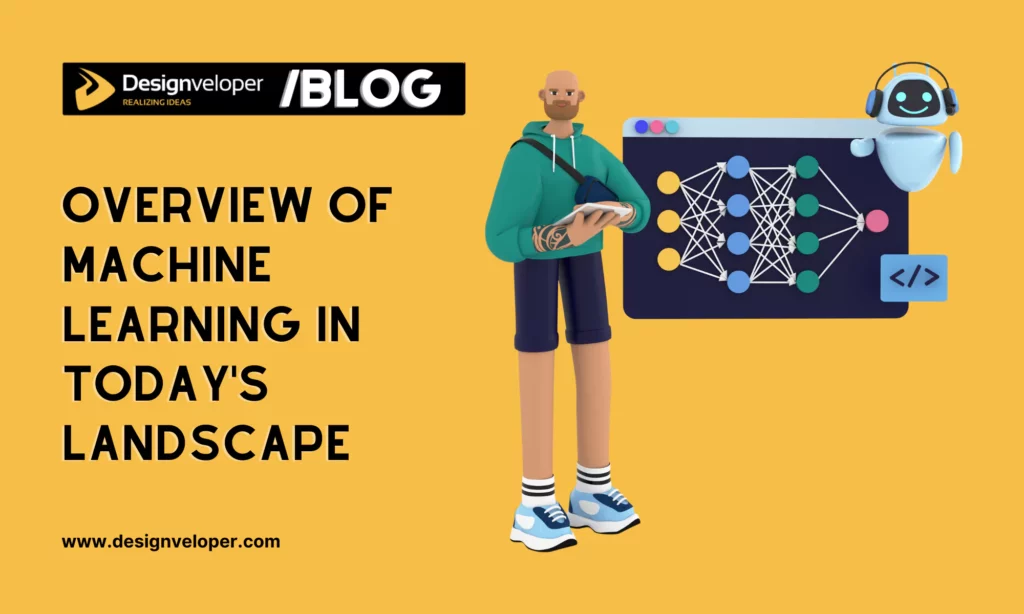
Machine learning is valued at more than $113 billion in 2025. This figure is expected to grow at lightning speed (equivalent to a CAGR of 34.8%) in the following five years. The rapid adoption of digital technologies for advanced data processing and analysis is one visible driver behind this growth, regardless of industries like healthcare or eCommerce.
Along with this growth, we’ve witnessed various key applications of machine learning today:
- Chatbots & Virtual Assistants: Intelligent assistants like Siri or Alexa use machine learning to recognize speech and implement interactions.
- Personalized Recommendations: Streaming platforms (e.g., Netflix), eCommerce website (e.g., Amazon), and more leverage ML to suggest movies and products based on user information (e.g., preferences or buying behaviors).
- Fraud Detection & Cybersecurity: Companies, especially banks and financial institutions, use ML to spot suspicious transactions and prevent fraud.
- Self-Driving Cars: Automotive companies like Tesla utilize ML to support navigation on the road (e.g., obstacle detection or lane keeping).
- Healthcare & Medical Diagnosis: ML models analyze medical images with high precision and help doctors identify diseases like cancer.
FURTHER READING: |
1. Machine Learning vs AI: Understanding the Key Differences |
2. 5 AI and Machine Learning Trends to Watch in 2025 |
3. NLP and ML in Paraphrasing Tool: How Does It Work? |
Future Trends of Machine Learning
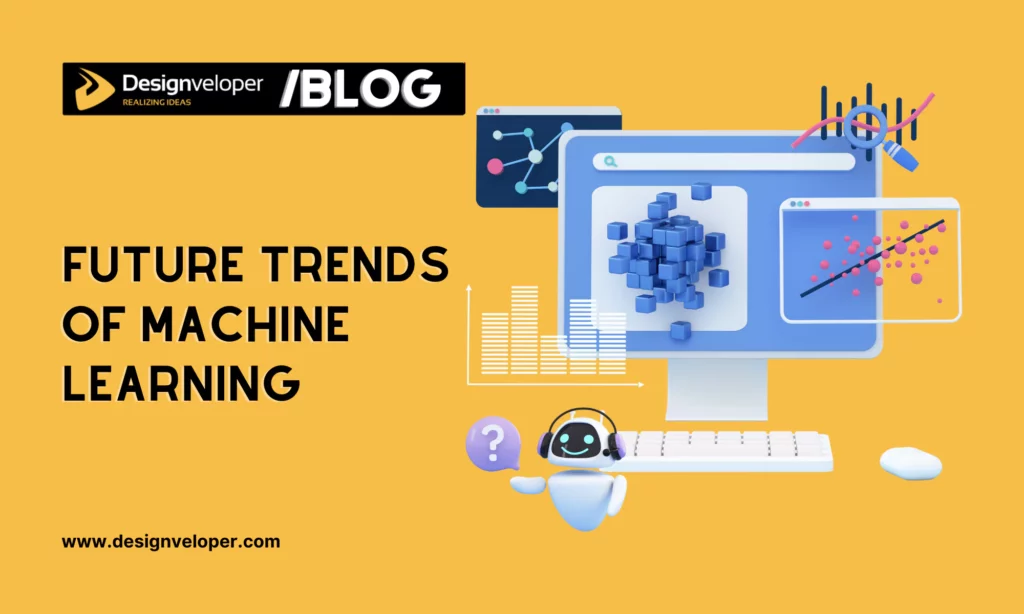
In addition to these outstanding applications of machine learning, we’ve seen the emergence of outstanding trends that are shaping the future of machine learning. They include:
1. Explainable AI (XAI)
XAI refers to machine learning models that explain their decisions for humans to understand. Unlike traditional “black box” models where we only see outcomes, XAI shows us why ML models make specific decisions or predictions.
The introduction of explainable AI helps handle one challenge of machine learning: “lack of transparency.” Especially in industries (e.g., healthcare or law enforcement) that require accountability in ML models, XAI helps improve trust in ML decisions and lead to a wider adoption.
ZestFinance, a California-based fintech startup, uses XAI to explain its credit scoring decisions. This helps lenders better know why borrowers are denied or approved (e.g., because they have stable employment history and consistent utility payments). Using XAI boosts the fairness and regulatory adherence of the platform.
Another example is PathAI, an AI-focused technology company in pathology solutions. The company uses XAI to help doctors understand why the AI platform makes its diagnoses, increasing their trust in this AI system.
2. Generative AI
If you’ve heard of ChatGPT, you may not be surprised when knowing it’s part of generative AI. Generative AI refers to models that can produce new content (e.g., text, images, or music) using technologies like GANs (Generative Adversarial Networks) or diffusion models. Today, with advancements in deep learning, you can create more realistic, creative content.
With this capability, GenAI is widely used in industries like entertainment or marketing. For example, RunwayML integrates this technology to allow creators to generate images, edit videos, and transform styles easily. Meanwhile, fashion companies like Stitch Fix or Nike have leveraged GenAI to design new products (e.g., clothing or sneakers) considering customer preferences and current trends.
3. Quantum Machine Learning (QML)
QML harnesses the power of quantum computing and machine learning to handle complex problems much faster than classical computers. With this capability, various companies are investing heavily in QML to speed up specific tasks (e.g., drug discovery and materials science) while ensuring their efficiency.
For instance, companies like Roche and Biogen have developed QML algorithms to detect diseases (i.e., diabetic retinopathy in medical images) and explore new drugs (i.e., by stimulating subtle molecular interactions). Meanwhile, financial institutions like HSBC or JPMorgan Chase also leverage quantum machine learning to analyze vast volumes of financial data exponentially faster and complete tasks like risk management or derivative pricing.
4. Automated Machine Learning (AutoML)
In the future, machine learning will not be the technology exclusively used by experts but also accessible by everyone. It’s all thanks to automated machine learning, or called AutoML. Accordingly, AutoML allows your business to automate the entire ML workflow, from data preprocessing and feature engineering to model selection.
Many companies now are using AutoML tools to develop, test, and deploy machine learning models for their unique needs. These tools (e.g., Qlik AutoML or Google AutoML) remove the need for a highly specialized team for every project.
For example, Siemens leverages Google’s AutoML Vision to build the Factory AI service which uses ML to automatically inspect products for defects. In finance, Capital One also uses AutoML to develop ML models for different tasks like fraud detection and credit scoring.
5. Reinforcement Learning
As a subsegment of machine learning, reinforcement learning refers to how an ML agent should interact in a dynamic environment to minimize the likelihood of penalties and achieve the best rewards. This is similar to how we learn through mistakes.
With this capability, reinforcement learning is ideal for tasks that need immediate decision-making in complex and dynamic environments. These tasks include developing ML agents (e.g., AlphaGo) that can play games like humans, training robots, and creating self-driving cars.
For example, AlphaGo used reinforcement learning algorithms to beat the top players in various competitions, typically in a five-game Go match with the top player Lee Sedol. Besides, Google uses RL, coupled with other advanced technologies like deep learning, to operate their self-driving cars. Accordingly, RL helps cars interact with the environment (e.g., roads or vehicles) and respond to unpredictable situations.
Future of Machine Learning: Challenges & Preparations
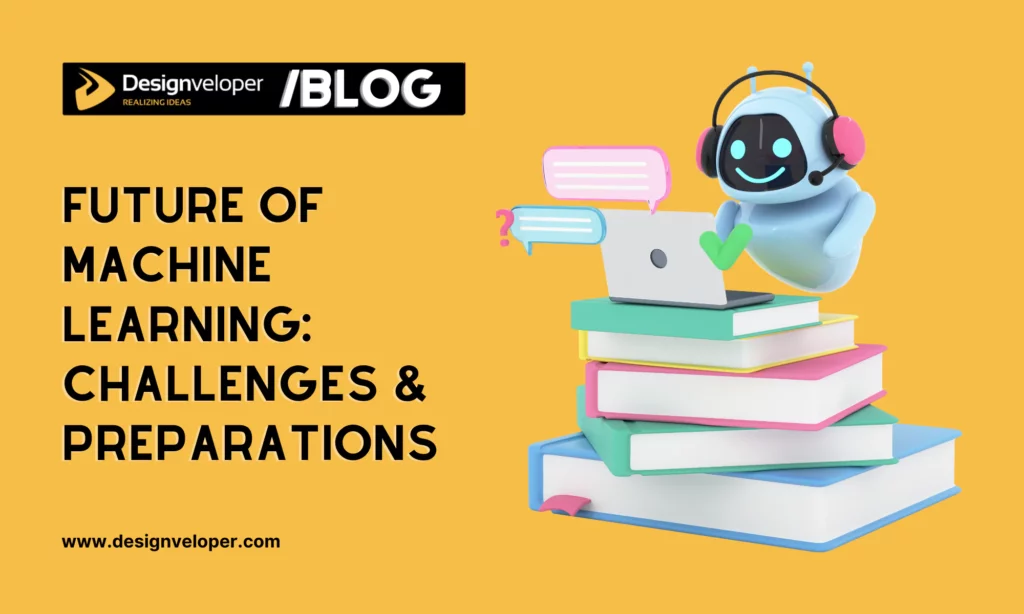
While machine learning brings undeniable benefits, it still comes with unexpected problems that exist presently and even in the future. Learning about ML also means recognizing these issues and having good preparations to stand out in this era.
Ethical Concerns
ML models don’t inherently contain biases. But the data used to train these models may have objective opinions and perspectives, leading to biases in ML algorithms. Biased ML models can cause unequal loan approvals, gender and racial discrimination in facial recognition, and more.
There are various types of biases to consider, like reporting bias, automation bias, or confirmation bias. To make ML models fair, Google advised you to notice some red flags within your data sources, like missing feature values, unexpected values, or data skew. Only when you spot the culprits behind bias, can you take proactive action to mitigate it.
Another ethical concern to consider is privacy issues. We all know ML algorithms depend on huge amounts of data for analytics and predictions. Collecting data, including personal and sensitive information, therefore, is essential to train ML models effectively. This is extremely beneficial in some industries like healthcare or finance, where ML algorithms use data to suggest personalized treatment or financial solutions. However, it’s challenging to ensure data security and collect data in the right ways while complying with regulatory requirements like GDPR or HIPAA.
Technical Challenges
Many companies now face technical challenges when leveraging ML models. The first one is regarding data scarcity or poor data quality. Not all the time these models can be trained on diverse, high-quality datasets. This holds them back from performing reliably and delivering accurate outcomes.
Second, some algorithms that ML models use to learn and make decisions aren’t accurate enough. Even small flaws in algorithms can produce wrong outcomes. Further, not all ML algorithms deliver the desired results, leading to a need for creating new and enhanced algorithms. This, however, requires lots of time, effort, and money for research and experiment.
Societal Challenges
Despite the visible benefits of machine learning, many people still refuse to use it for some reason like lack of transparency or accuracy. In other words, they don’t know how ML models make a decision and whether the decision is accurate or not. These prejudices hinder a wide adoption of this advanced technology although there are many current efforts to handle these problems.
What Should You Do to Handle These Problems?
According to the 2025 McKinsey Digital report, up to 92% of companies plan to increase their AI/ML investments. However, only 1% of them are confident to regard themselves as “mature” in fully deploying AI/ML in their workflows and creating significant business outcomes.
So, to make the most use of machine learning and prepare the workforce for the future of machine learning, your business should focus on education and training. This often involves developing programs to make everyone ML-literate as well as upskill and reskill workers whose jobs are significantly impacted by automation.
Further, your business should devise strategies for ML adoption. They may include investing in ML infrastructure (e.g., hardware or software), identifying opportunities to use ML for operational efficiency or new product development, and collaborating with ML experts.
Besides, you should develop ethical ML practices to address the challenges of machine learning. These practices not only ensure the responsible use of machine learning but also help comply with industry regulations.
Will Machine Learning Replace Humans?
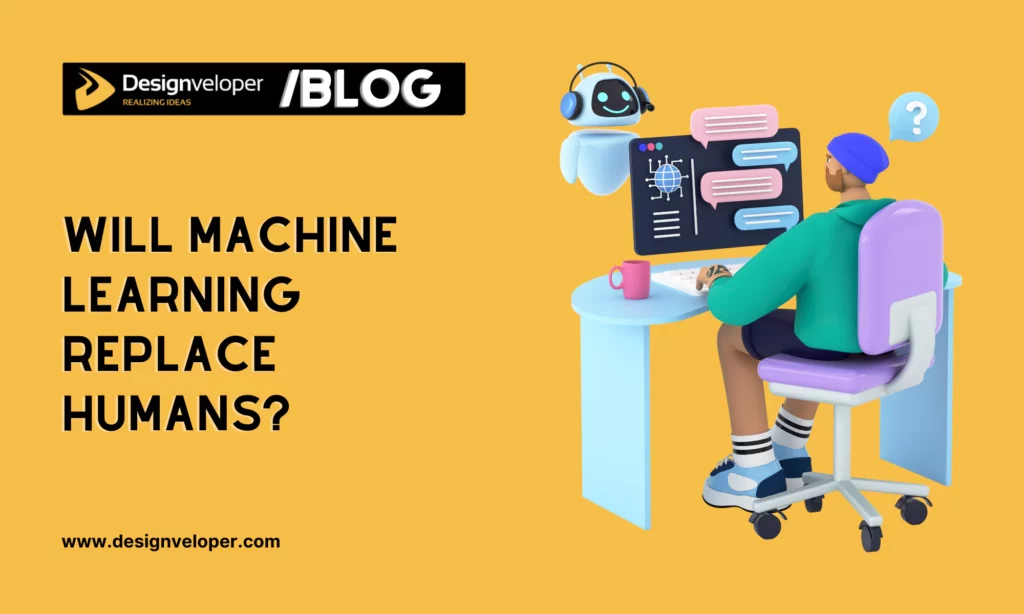
The growth of machine learning raises a big question: Will it take our job? It’s a visible concern, yet the answer is: possibly not in the way many people fear. Although machine learning significantly impacts our job market, it still can’t completely replace human beings.
Debunk the Myth
It’s true that machine learning excels at analyzing huge datasets, identifying patterns, and making predictions. Therefore, it can automatically do tasks like data entry or quality control in manufacturing faster (and better!) than humans. For this reason, around 40% of employers plan to reduce their workforce in tasks that AI can automate.
Having said that, ML still lacks specific human capabilities, such as emotional intelligence, creativity, or complex decision-making. Therefore, jobs that require these qualities still need people.
New Job Creation
The rise of machine learning, despite threatening specific jobs like data entry, has paved the way for other jobs to thrive. According to the 2025 World Economic Forum report, such jobs as AI/ML specialists or data-related experts (e.g., data analysts) are considered the fastest-growing.
Further, we’ll witness a growing demand for these jobs in industries like healthcare, retail, IT, and BFSI (Banking, Financial Services, and Insurance). For example, in healthcare, ML capabilities like computer vision and deep learning are widely used to support the diagnosis and early detection of some diseases that are hard to spot with the naked eye.
Focus on Collaboration and Demanding Skills
In the future, we’ll witness a growing adoption of machine learning across departments within a business. Additionally, there’s a closer collaboration between humans and machines instead of the scenario of machines completely replacing humans. For instance, ML can analyze medical images to detect subtle patterns faster while doctors make the final diagnosis.
Further, people should equip themselves with essential skills to survive in today’s era when machine learning appears everywhere. Skills like AI, big data, and technological literacy top the list of fastest-growing skills, as reported by the World Economic Forum. In addition to these tech-related skills, employers increasingly pay importance to soft skills like creative thinking, resilience, and agility. Therefore, honing these skills gives employees a competitive edge to stand out in today’s job market.
Final Thoughts: Thrive with Designveloper’s ML Solutions

This article gave you a detailed overview of the future of machine learning, from its potential trends to challenges. According to estimations, this technology continues to thrive strongly with the emergence of key trends like quantum computing or no-code models. So, to not fall behind the era where machine learning is dominating every aspect of our lives, devising a meticulous strategy to adopt and integrate this tech is a necessity.
If you’re looking for a trusted, experienced partner in this realm, consider Designveloper! With years of deep expertise and experience in AI/ML, we’re committed to delivering the best solutions that align with your business and scale along with your changing demands.
Here at Designveloper, our top-notch team of engineers offers services such as AI/ML software development, generative AI, and chatbot integration. With our AI/ML solutions, you can say goodbye to repetitive tasks and focus on more strategic, creative initiatives while ensuring work quality and improving operational efficiency.
Wanna share your idea with us? Don’t hesitate to contact us today and bring your idea to life! In case you’d like to receive more interesting posts about this topic, subscribe to our blog now and follow us on Facebook, X, and LinkedIn!






Read more topics




























